Wind Energy Implementation to Mitigate Wildfire Risk and Preemptive Blackouts
Abstract
:1. Introduction
2. Materials and Methods
3. Results
3.1. Risk Assessment from Wildfire and Blackouts
3.2. Existing Wind Farms to Supply Local PSPS Cities
4. Discussion
4.1. Proposed Onshore Wind Turbines
4.2. Proposed Offshore Wind Farms
5. Conclusions
Funding
Acknowledgments
Conflicts of Interest
Abbreviations
| CFSR | Climate Forecast System Reanalysis |
| CPUC area | Fire-Threat areas (2 and 3) according to the California Public Utilities Commission |
| DTU | Technical University of Denmark |
| GIS | Geographic Information Systems |
| NOOA | U.S. National Oceanic and Atmospheric Administration |
| PG&E | Pacific Gas and Electric Company–providing electric power in Northern California |
| PSPS | Public Safety Power Shutoff area |
| QGIS | Quantum GIS. Open-source GIS application |
| SCE | Southern California Edison-providing electric power in Southern California |
References
- Mitchell, J.W. Power line failures and catastrophic wildfires under extreme weather conditions. Eng. Fail. Anal. 2013, 35, 726–735. [Google Scholar] [CrossRef]
- Kousky, C.; Greig, K.; Lingle, B.; Kunreuther, H. Wildfire Costs in California: The Role of Electric Utilities. Wharton Risk Center, 2018. Available online: https://riskcenter.wharton.upenn.edu/wp-content/uploads/2018/08/Wildfire-Cost-in-CA-Role-of-Utilities-1.pdf (accessed on 2 January 2020).
- Cal Fire. GIS Data. 2019. Available online: https://frap.fire.ca.gov/mapping/gis-data/ (accessed on 2 January 2020).
- CalFire. Top 20 Most Destructive California Wildfires. 2019. Available online: https://www.fire.ca.gov/media/5511/top20_destruction.pdf (accessed on 2 January 2020).
- Rice, D. USA had world’s 3 costliest natural disasters in 2018, and Camp Fire was the worst. USA TODAY. 8 January 2019. Available online: https://www.usatoday.com/story/news/2019/01/08/natural-disasters-camp-fire-worlds-costliest-catastrophe-2018/2504865002/ (accessed on 2 January 2020).
- Sommer, L. Are Blackouts the Future for California? National Public Radio (NPR). Energy 2019. Available online: https://www.npr.org/2019/10/21/771280208/are-blackouts-the-future-for-california (accessed on 2 January 2020).
- Most, W.B.; Weissman, S. Trees and Power Lines: Minimizing Conflicts between Electric Power Infrastructure and the Urban Forest; Center for Law, Energy & the Environment Berkeley Law: University of California, Berkeley, CA, USA, 2012. [Google Scholar]
- Garcetti, E.; Feuer, M.H.M. Re: It Only Takes a Spark: Enhancing DWP’s Wildfire Prevention Strategy; LA Comptroller Office: Los Angeles, CA, USA, 2019. [Google Scholar]
- Syphard, A.; Keeley, J. Location, timing and extent of wildfire vary by cause of ignition. Int. J. Wildland Fire 2015, 24, 37–47. [Google Scholar] [CrossRef]
- Hall, K.L. Out of Sight, Out of Mind 2012: An Updated Study on the Undergrounding of Overhead Power Lines. A Report Prepared for Edison Electric Institute. 2013. Available online: http://www.eei.org (accessed on 2 January 2020).
- Sandler, R. PG&E Says Faulty Power Lines May Have Sparked 2 California Wildfires. Forbes Magazine. 28 October 2019. Available online: https://www.forbes.com/sites/rachelsandler/2019/10/28/pge-says-faulty-power-lines-may-have-sparked-2-california-wildfires/#2a7f34bf2584 (accessed on 2 January 2020).
- PG&E Public Safety Power Shut off (PSPS) Planning Maps. 2020. Available online: https://www.pge.com/en_US/safety/emergency-preparedness/natural-disaster/wildfires/psps-planning-maps.page (accessed on 4 December 2019).
- SCE. Southern California Edison Company’s Progress Report on the Implementation of De-energization Guidelines set forth in Appendix “A” of Decision 19-05-042. 2019. Available online: https://www.cpuc.ca.gov/uploadedFiles/CPUCWebsite/Content/News_Room/NewsUpdates/2019/SCE_PSPSProgressReport.pdf (accessed on 31 March 2020).
- SCE. Public Safety Power Shut off (PSPS) Planning Maps. SCE Document library, 2020. Available online: http://www.sce.com/maps (accessed on 31 March 2020).
- CPUC. FireMap Tier 2 and Tier 3 Fire-Threat Areas GIS Data. 2020. Available online: https://ia.cpuc.ca.gov/firemap/ (accessed on 9 December 2019).
- USCB-US Census Bureau Mapping Files. TIGER/Line Shapefiles; U.S. Department of Commerce Geography Division, U.S. Census Bureau, 2019. Available online: https://www.census.gov/geographies/mapping-files/time-series/geo/tiger-line-file.html (accessed on 6 January 2020).
- USCB-US Census Bureau Centers of Population. 2010. Available online: https://www.census.gov/geographies/reference-files/time-series/geo/centers-population.html (accessed on 6 January 2020).
- Vestas Wind Systems. General Description 3MW Platform. In Power curves. Eastern Fields Wind Power Project; Design and Operations Report; Vestas Wind Systems A/S: Aarhus, Denmark, 2017.
- Vestas-Vestas Wind Systems 4 MW Platform. 02/2020-EN. 2020. Available online: http://nozebra.ipapercms.dk/Vestas/Communication/Productbrochure/4MWbrochure/4MWProductBrochure/?page=2 (accessed on 2 March 2020).
- Onea, F.; Rusu, E. An Assessment of Wind Energy Potential in the Caspian Sea. Energies 2019, 12, 2525. [Google Scholar] [CrossRef] [Green Version]
- AWEA-American Wind Energy Association. WindIQ Database; American Wind Energy Association: Washington, DC, USA, 2020; Available online: https://windiq.awea.org/ (accessed on 6 March 2020).
- Rampion. Rampion Offshore Wind Farm. Presentation Overview. October 2017. Available online: https://www.rampionoffshore.com/app/uploads/2017/11/General-Rampion-Presentation (accessed on 3 March 2020).
- Rojowsky, K.; Beaucage, P.; Johanson, C. Generation Profiles for Operational Plants. Ref. No.: 17-12-019252; Technical report. ERCOT Wind Patterns for Existing Sites, 1980–2017; Electric Reliability Council of Texas (ERCOT): Taylor, TX, USA, 6 September 2018; Available online: http://www.ercot.com/gridinfo/resource (accessed on 3 February 2020).
- NOAA. Climate Forecast System Reanalysis CFSR. NARR, 2019. Available online: https://www.ncdc.noaa.gov/data-access/model-data/model-datasets/reanalysis (accessed on 9 September 2019).
- DTU. Global Wind Atlas 3.0; Technical University of Denmark: Lyngby, Denmark; World Bank Group; Vortex, 2019; Available online: https://globalwindatlas.info/ (accessed on 13 November 2019).
- Hayajneh, H.S.; Zhang, X. Logistics Design for Mobile Battery Energy Storage Systems. Energies 2020, 13, 1157. [Google Scholar] [CrossRef] [Green Version]
- Boretti, A. Energy storage requirements to address wind energy variability. Energy Storage 2019, 1, 77. [Google Scholar] [CrossRef] [Green Version]
- HIFLD-Homeland Infrastructure Foundation Level Data. Electric Power Transmission Lines; GeoPlatform-Federal Geographic Data Committee (FGDC), 24 September 2019. Available online: https://hifld-geoplatform.opendata.arcgis.com/datasets/electric-power-transmission-lines (accessed on 13 November 2019).
- Haces-Fernandez, F.; Martinez, A.; Camacho, L.; Ramirez, D.; Su, H.; Li, H. GIS based tool for analyzing US wind farms development. IIE Annual Conference. Proceedings; Institute of Industrial and Systems Engineers (IISE), 2017; pp. 109–114. Available online: https://search.proquest.com/openview/0ed61cba9a9f510d9d1c10352bc65b9d/1?pq-origsite=gscholar&cbl=51908 (accessed on 13 November 2019).
- Hoen, B.D.; Diffendorfer, J.E.; Rand, J.T.; Kramer, L.A.; Garrity, C.P.; Hunt, H.E. United States Wind Turbine Database. U.S. Geological Survey, American Wind Energy Association, and Lawrence Berkeley National Laboratory data release: USWTDB V2.3; January 2020. Available online: https://eerscmap.usgs.gov/uswtdb (accessed on 14 January 2020).
- Díaz-Cuevas, P. GIS-Based Methodology for Evaluating the Wind-Energy Potential of Territories: A Case Study from Andalusia (Spain). Energies 2018, 11, 2789. [Google Scholar] [CrossRef] [Green Version]
- Ali, S.; Jang, C.-M. Selection of Best-Suited Wind Turbines for New Wind Farm Sites Using Techno-Economic and GIS Analysis in South Korea. Energies 2019, 12, 3140. [Google Scholar] [CrossRef] [Green Version]
- Gold, R. Superpower: One Man’s Quest to Transform American Energy Hardcover; Simon & Schuster: New York, NY, USA, 2019; Chapter 1; pp. 3–7. [Google Scholar]
- Sun, Y.; Ma, X.; Xu, J.; Bao, Y.; Liao, S. Efficient utilization of wind power: Long-distance transmission or local consumption? Front. Mech. Eng. 2017, 12, 440–455. [Google Scholar] [CrossRef]
- Jankowiak, C.; Zacharopoulos, A.; Brandoni, C.; Keatley, P.; MacArtain, P.; Hewitt, N. The Role of Domestic Integrated Battery Energy Storage Systems for Electricity Network Performance Enhancement. Energies 2019, 12, 3954. [Google Scholar] [CrossRef] [Green Version]
- Musial, W.; Beiter, P.; Tegen, S.; Smith, A. Potential Offshore Wind Energy Areas in California: An Assessment of Locations, Technology, and Costs (No. NREL/TP-5000-67414); National Renewable Energy Lab (NREL): Golden, CO, USA, 2016. [Google Scholar]
- Haces-Fernandez, F.; Li, H.; Jin, K. investigation into the possibility of extracting wave energy from the texas coast. Int. J. Energy A Clean Environ. 2019, 20, 23–41. [Google Scholar] [CrossRef]
- Haces-Fernandez, F.; Li, H.; Ramirez, D. Assessment of the Potential of Energy Extracted from Waves and Wind to Supply Offshore Oil Platforms Operating in the Gulf of Mexico. Energies 2018, 11, 1084. [Google Scholar] [CrossRef] [Green Version]
- Zheng, X.; Zheng, H.; Lei, Y.; Li, Y.; Li, W.; Zheng, L. An Offshore Floating Wind–Solar–Aquaculture System: Concept Design and Extreme Response in Survival Conditions. Energies 2020, 13, 604. [Google Scholar] [CrossRef] [Green Version]
- Penn, Ivan; Reed, Stanley (2018) Something New May Be Rising Off California Coast: Wind Farms. The New York Times. 19 October 2018. Available online: https://www.nytimes.com/2018/10/19/business/energy-environment/california-coast-wind-farms.html (accessed on 2 April 2020).
- Haces-Fernandez, F.; Li, H.; Ramirez, D. Assessment of Wind Energy in the United States Gulf of Mexico Area as Power Supply for Offshore Oil Platforms. In Proceedings of the Offshore Technology Conference, Houston, TX, USA, 30 April–3 May 2018; Society of Petroleum Engineers (SPE), 2018. Available online: https://www.onepetro.org/conference-paper/OTC-29044-MS (accessed on 2 April 2020).
- Kucuksari, S.; Erdogan, N.; Cali, U. Impact of Electrical Topology, Capacity Factor and Line Length on Economic Performance of Offshore Wind Investments. Energies 2019, 12, 3191. [Google Scholar] [CrossRef] [Green Version]
- Alabdullatif, A.; Gerding, E.; Perez-Diaz, A. Market Design and Trading Strategies for Community Energy Markets with Storage and Renewable Supply. Energies 2020, 13, 972. [Google Scholar] [CrossRef] [Green Version]


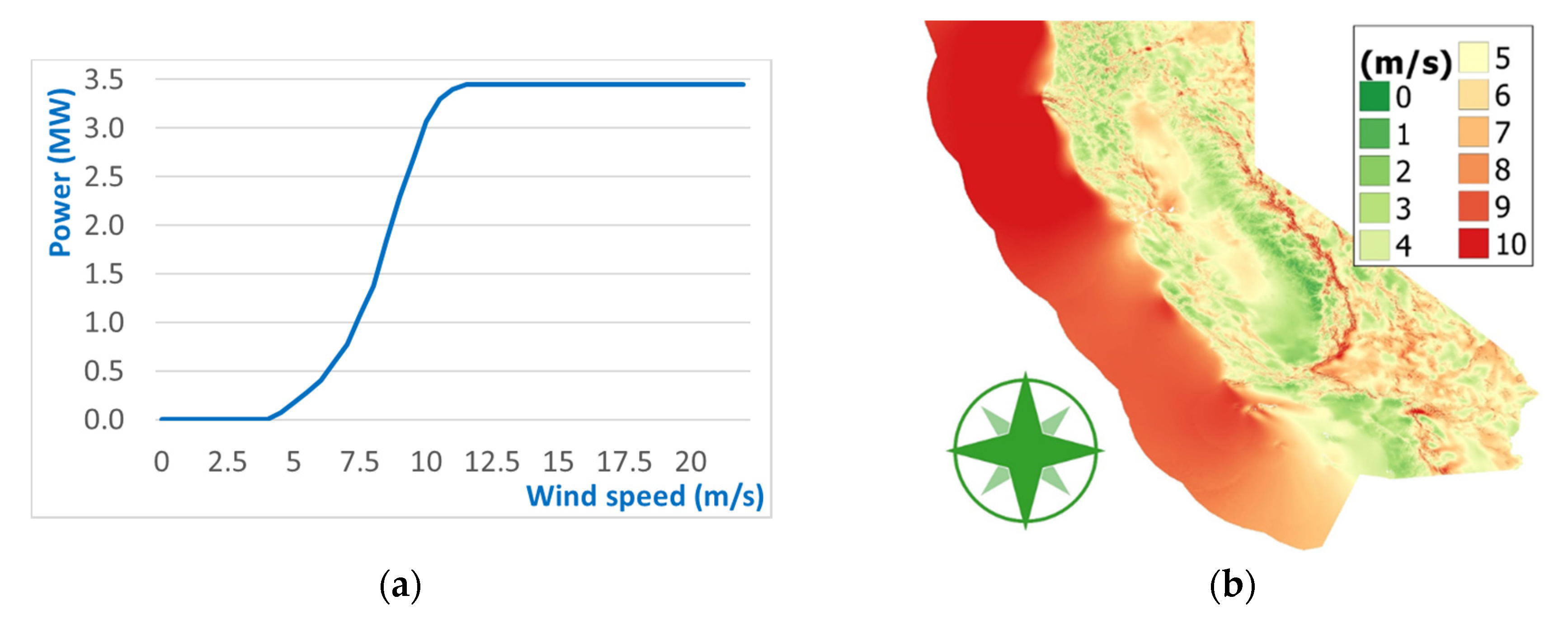





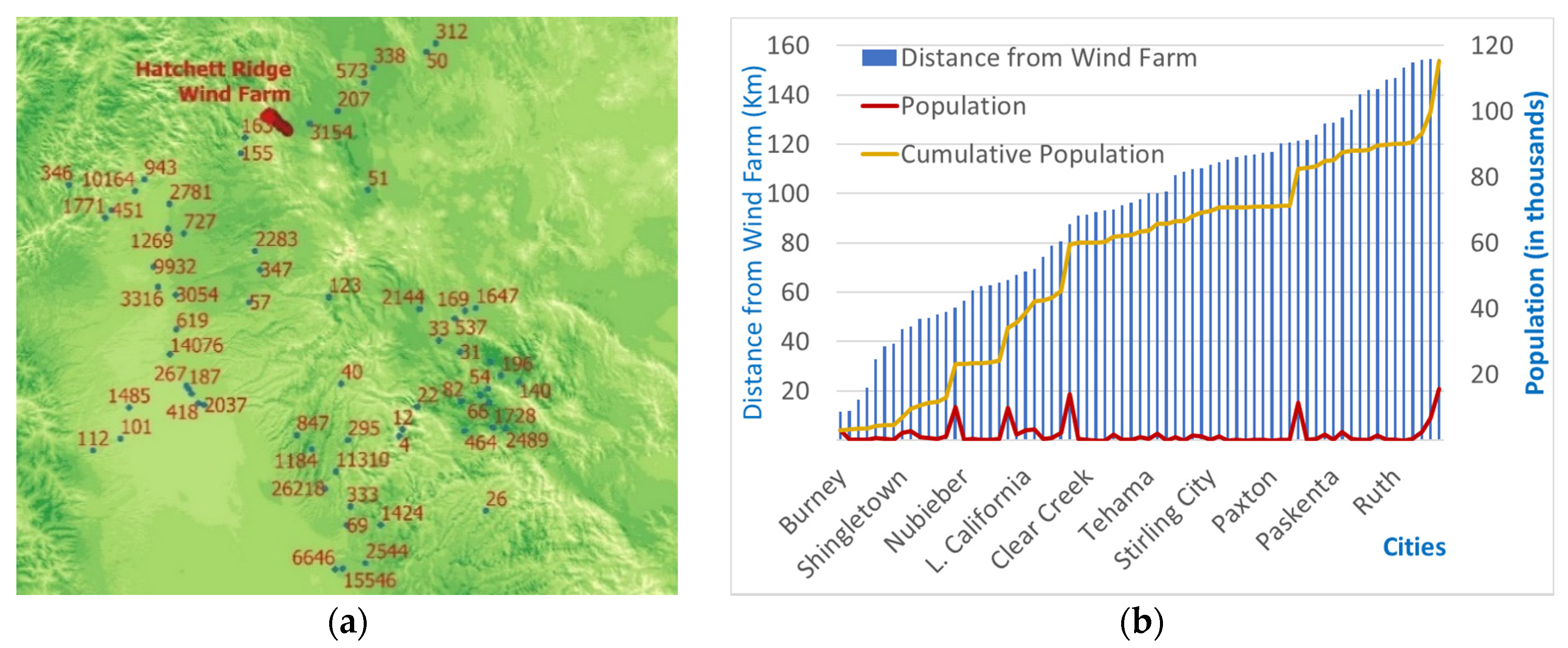

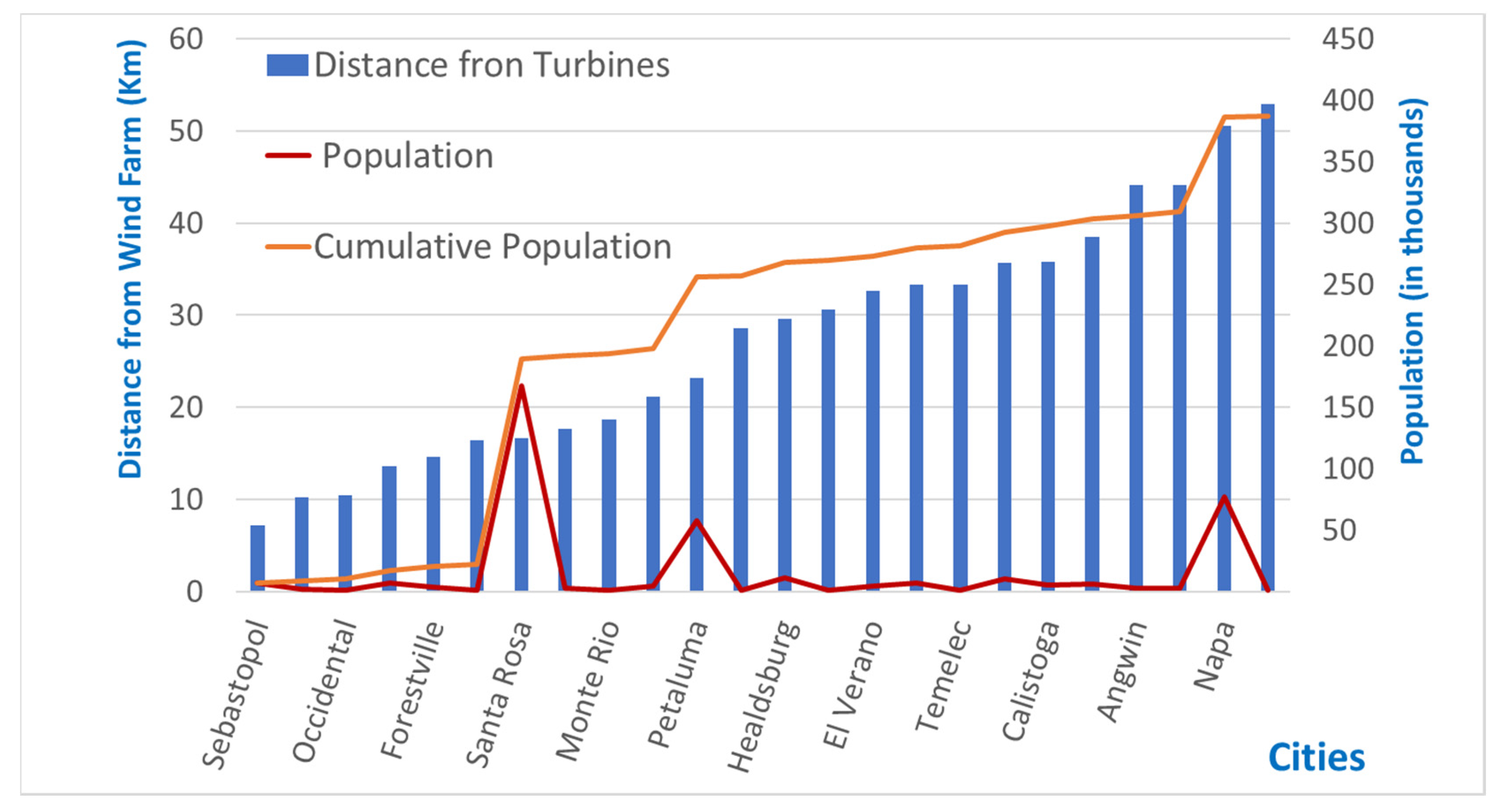
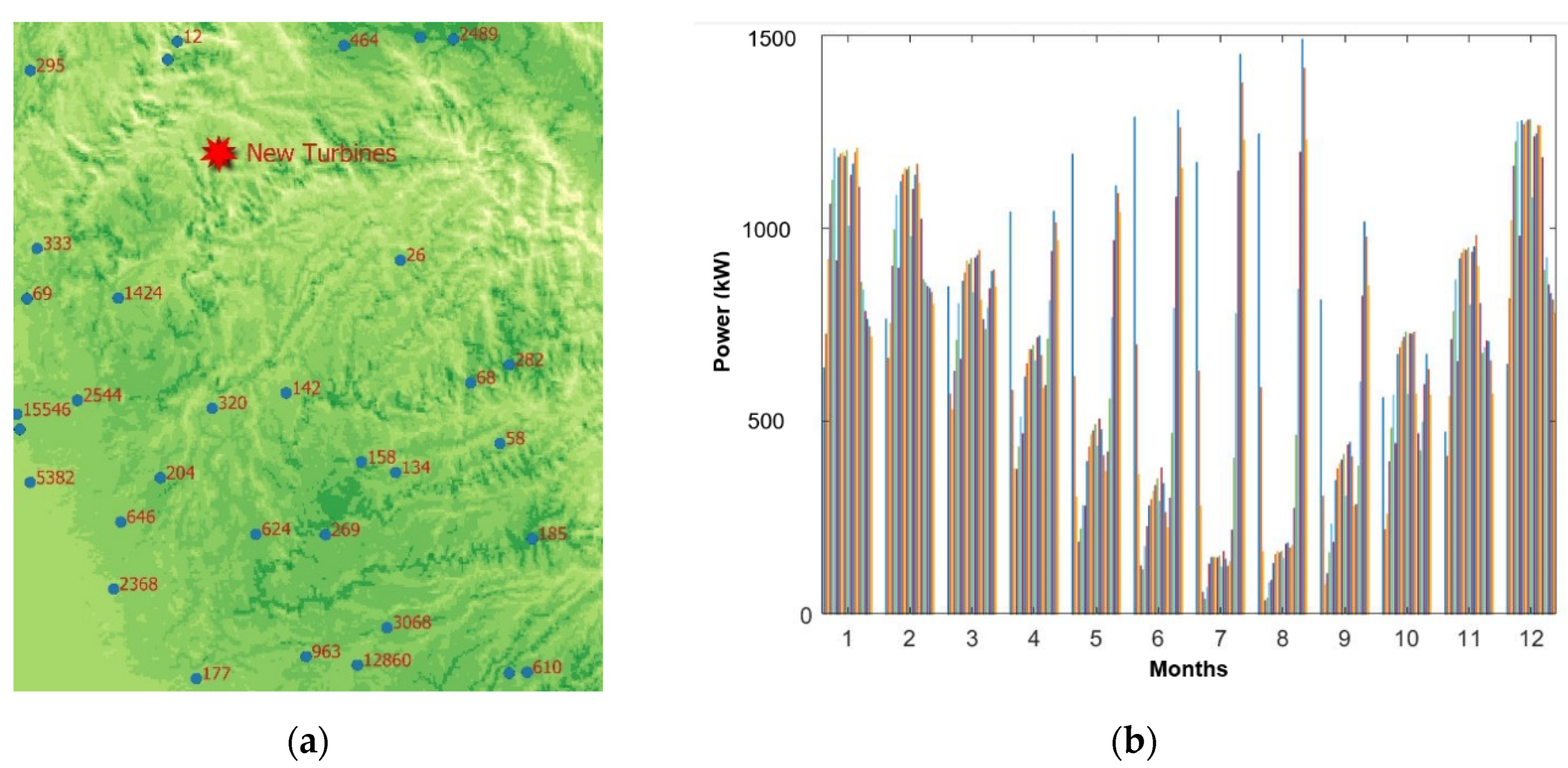
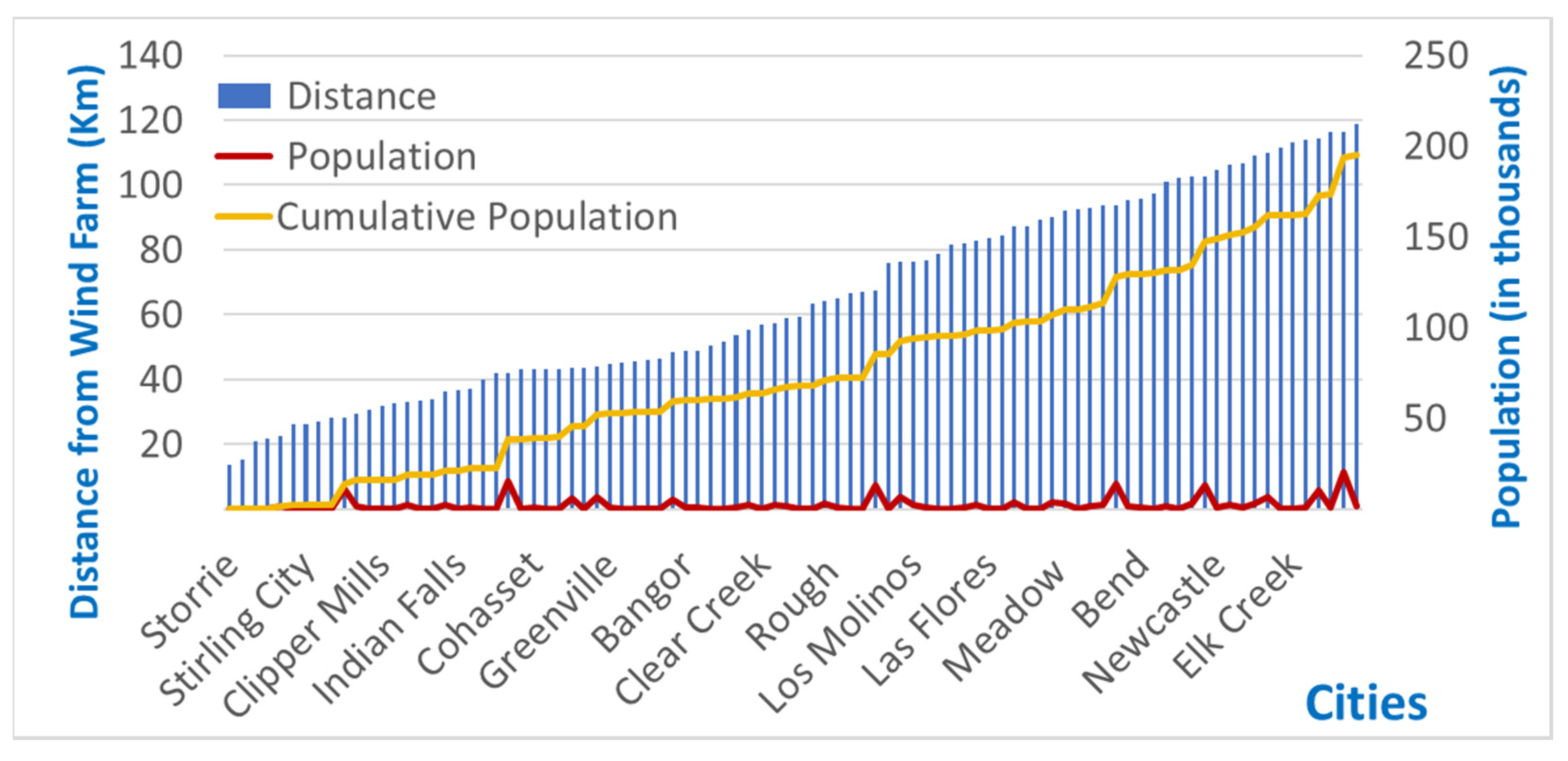

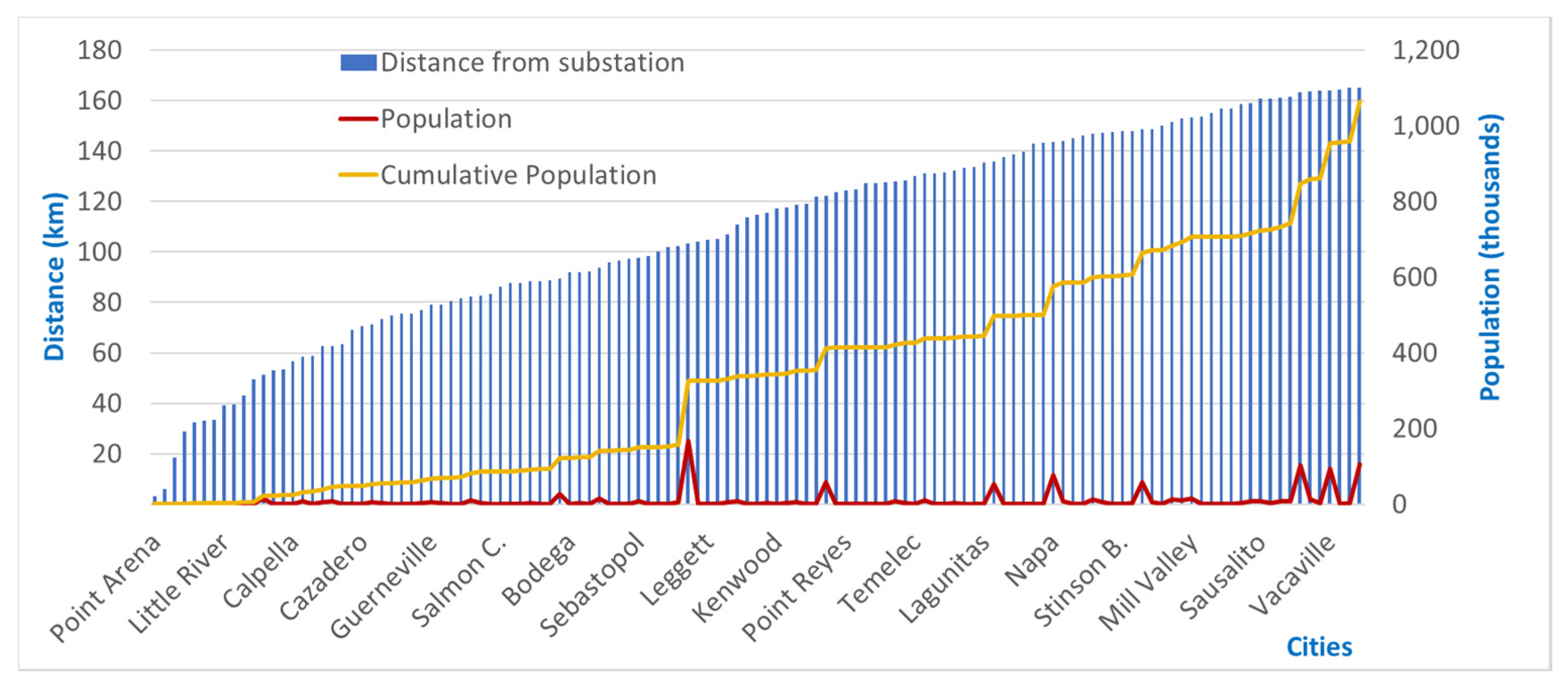
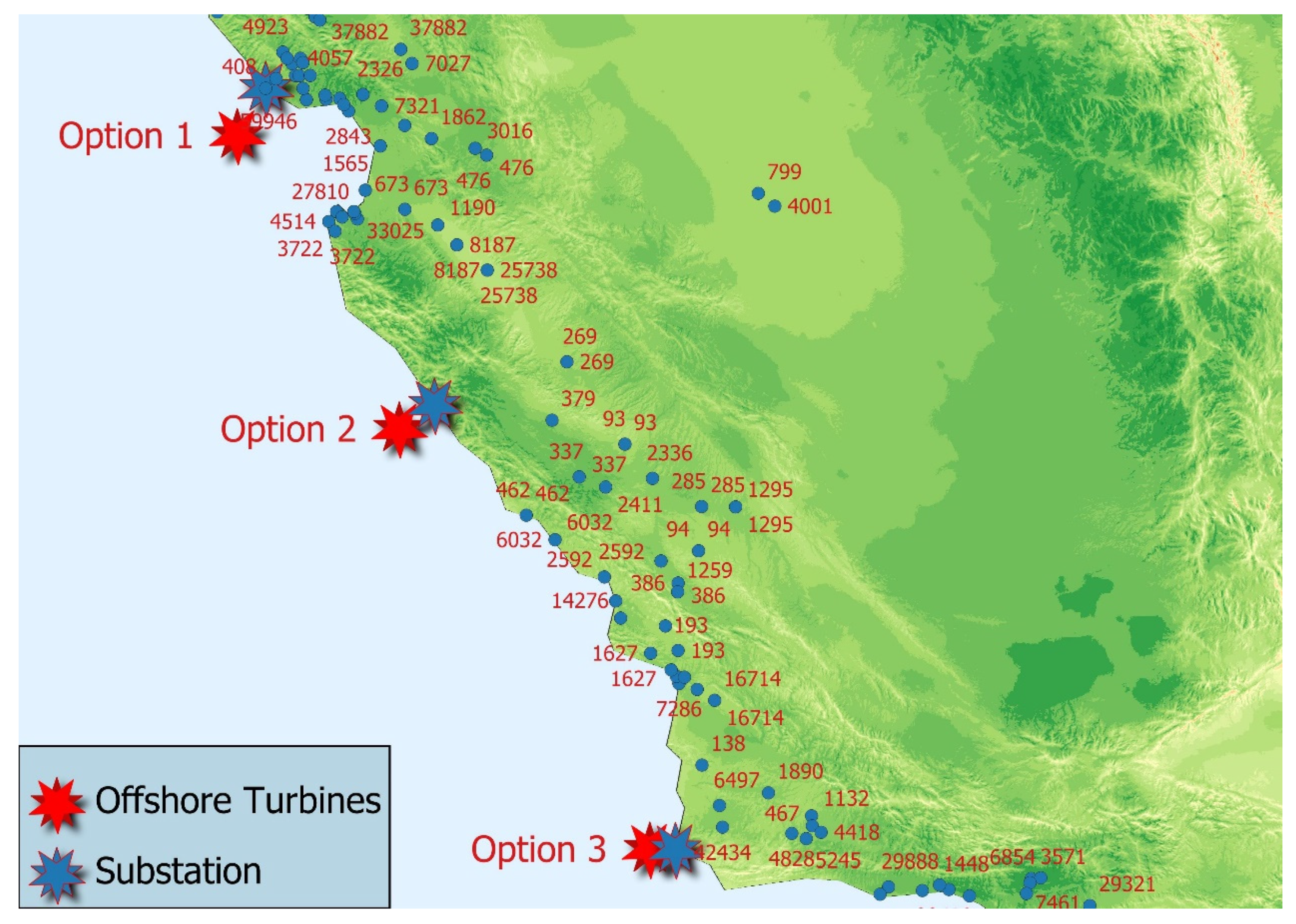

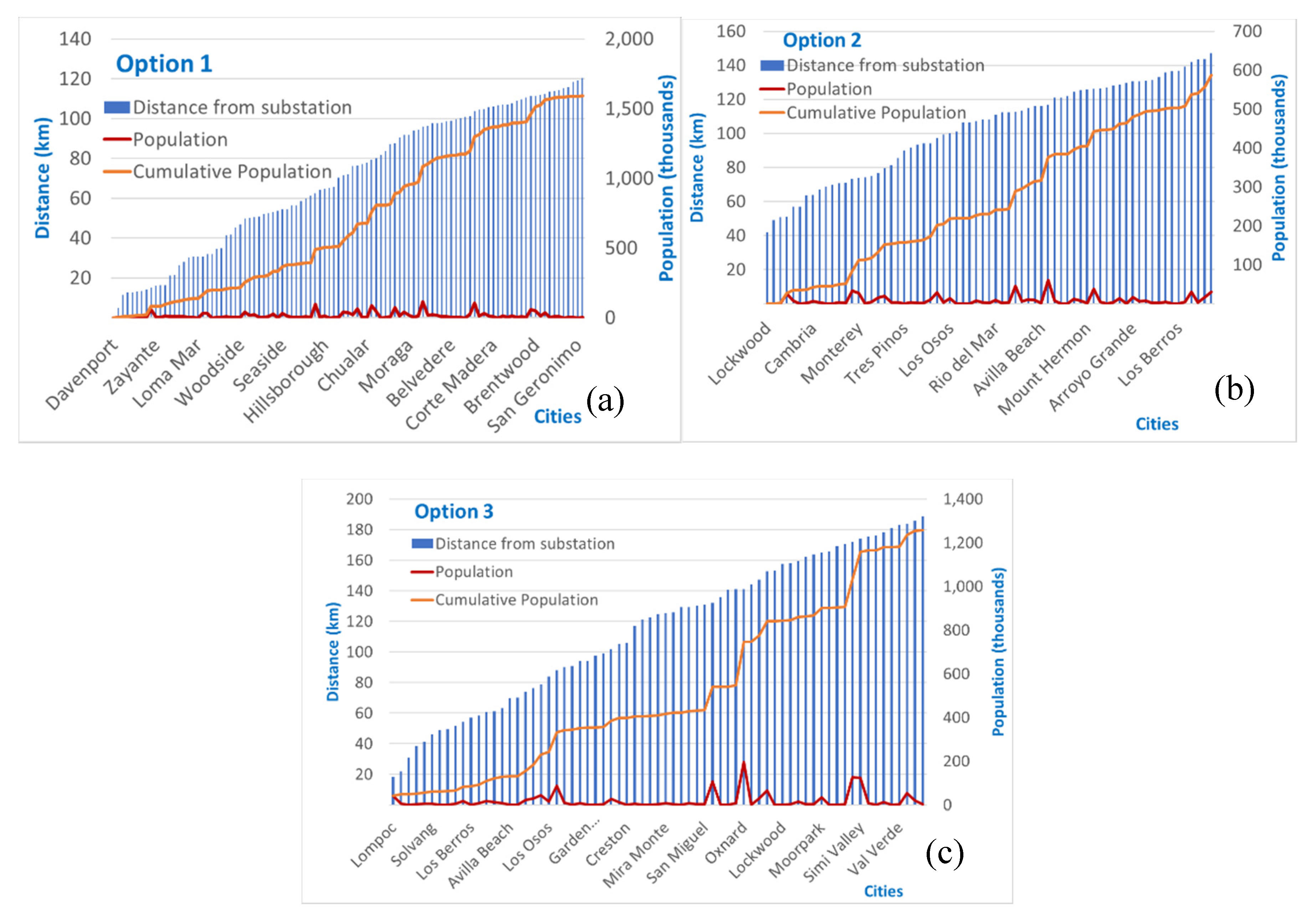
| Pop (Thousands) | Num of PSPS | PSPS Area (Km2) | PSPS Affected (%) | Cities Affected by Several PSPS | ||||||||||
|---|---|---|---|---|---|---|---|---|---|---|---|---|---|---|
| Avg | Max | Min | Tier 2 | Tier 3 | 1 | 2 | 3 | 4 | 5 | 6 | 7 | 9 | ||
| 0–10 | 315 | 126 | 1034 | 2 | 48 | 23 | 216 | 113 | 33 | 6 | 1 | - | - | - |
| 10–20 | 75 | 59 | 500 | 5 | 32 | 21 | 9 | 12 | 5 | 4 | 3 | 1 | - | - |
| 20–30 | 40 | 48 | 614 | 2 | 30 | 23 | 3 | 3 | 1 | 2 | 2 | - | - | 1 |
| 30–40 | 12 | 68 | 179 | 16 | 32 | 10 | 3 | - | 2 | - | - | - | - | - |
| 40–50 | 17 | 47 | 216 | 6 | 27 | 15 | 1 | 2 | 1 | 1 | - | - | - | - |
| 50–60 | 12 | 41 | 127 | 5 | 26 | 16 | 1 | - | 3 | - | - | - | 1 | - |
| >60 | 21 | 28 | 72 | 6 | 20 | 9 | 6 | 2 | 2 | - | - | - | - | - |
| Pop (Thousands) | Num of PSPS | PSPS Area (Km2) | PSPS Affected (%) | Cities Affected by Several PSPS | |||||||||||
|---|---|---|---|---|---|---|---|---|---|---|---|---|---|---|---|
| Avg | Max | Min | Tier 2 | Tier 3 | 1 | 2 | 3 | 4 | 5 | 6 | 7 | 11 | 12 | ||
| 0–10 | 161 | 41 | 551 | 1 | 43 | 27 | 50 | 45 | 13 | 7 | 0 | 0 | 0 | 0 | 0 |
| 10–20 | 74 | 21 | 192 | 1 | 11 | 34 | 5 | 10 | 7 | 3 | 1 | 1 | 1 | 0 | 0 |
| 20–30 | 64 | 17 | 128 | 0.88 | 11 | 27 | 3 | 7 | 6 | 5 | 1 | 0 | 0 | 0 | 0 |
| 30–40 | 62 | 3 | 19 | 0.40 | 6 | 19 | 1 | 3 | 3 | 3 | 0 | 1 | 1 | 1 | 1 |
| 40–50 | 29 | 6 | 16 | 0.79 | 32 | 4 | 1 | 1 | 5 | 0 | 0 | 2 | 0 | 0 | 0 |
| 50–60 | 36 | 12 | 143 | 0.54 | 7 | 36 | 1 | 4 | 3 | 2 | 1 | 1 | 0 | 0 | 0 |
| >60 | 99 | 10 | 86 | 0.334 | 11 | 18 | 5 | 9 | 10 | 5 | 2 | 1 | 1 | 0 | 0 |
© 2020 by the author. Licensee MDPI, Basel, Switzerland. This article is an open access article distributed under the terms and conditions of the Creative Commons Attribution (CC BY) license (http://creativecommons.org/licenses/by/4.0/).
Share and Cite
Haces-Fernandez, F. Wind Energy Implementation to Mitigate Wildfire Risk and Preemptive Blackouts. Energies 2020, 13, 2421. https://doi.org/10.3390/en13102421
Haces-Fernandez F. Wind Energy Implementation to Mitigate Wildfire Risk and Preemptive Blackouts. Energies. 2020; 13(10):2421. https://doi.org/10.3390/en13102421
Chicago/Turabian StyleHaces-Fernandez, Francisco. 2020. "Wind Energy Implementation to Mitigate Wildfire Risk and Preemptive Blackouts" Energies 13, no. 10: 2421. https://doi.org/10.3390/en13102421





